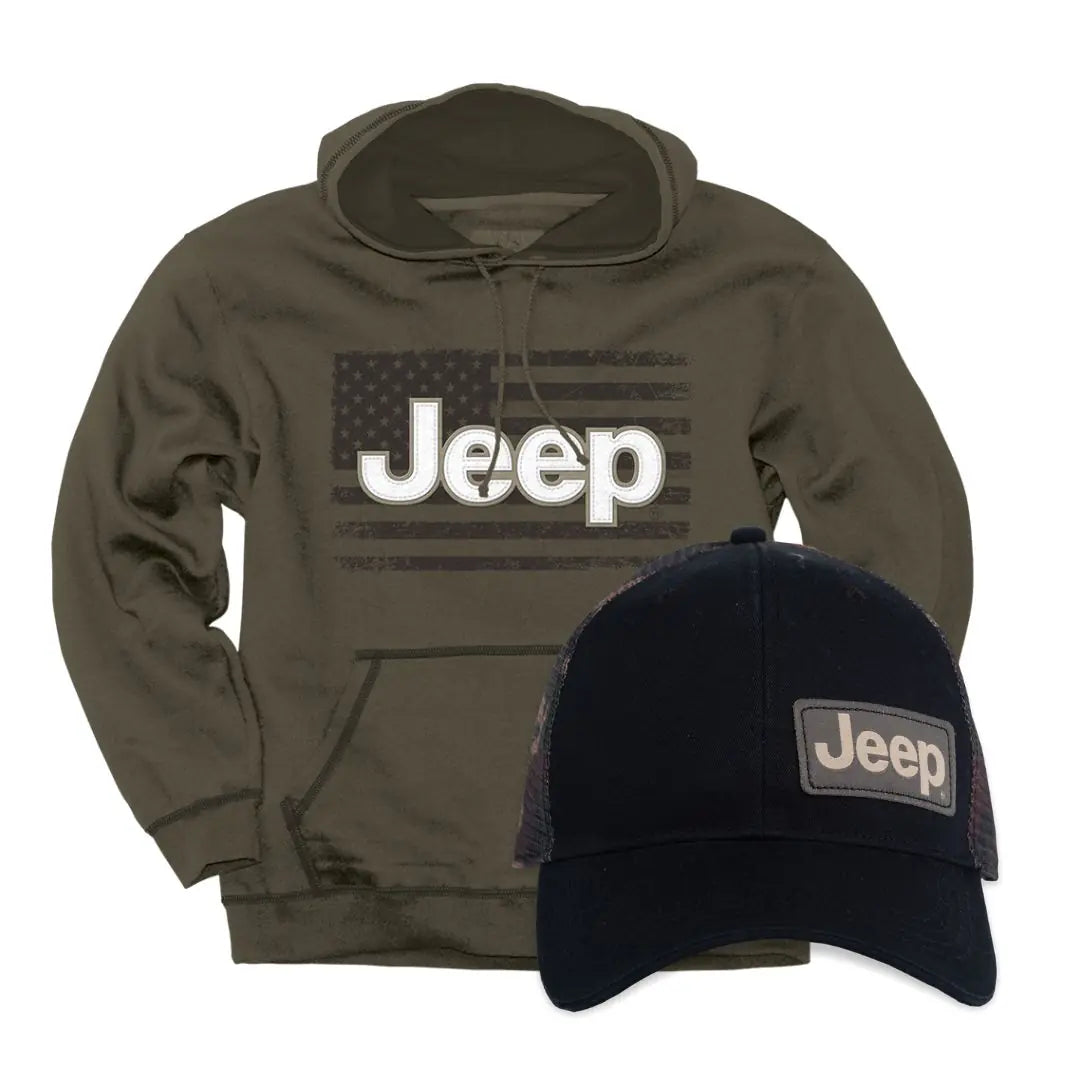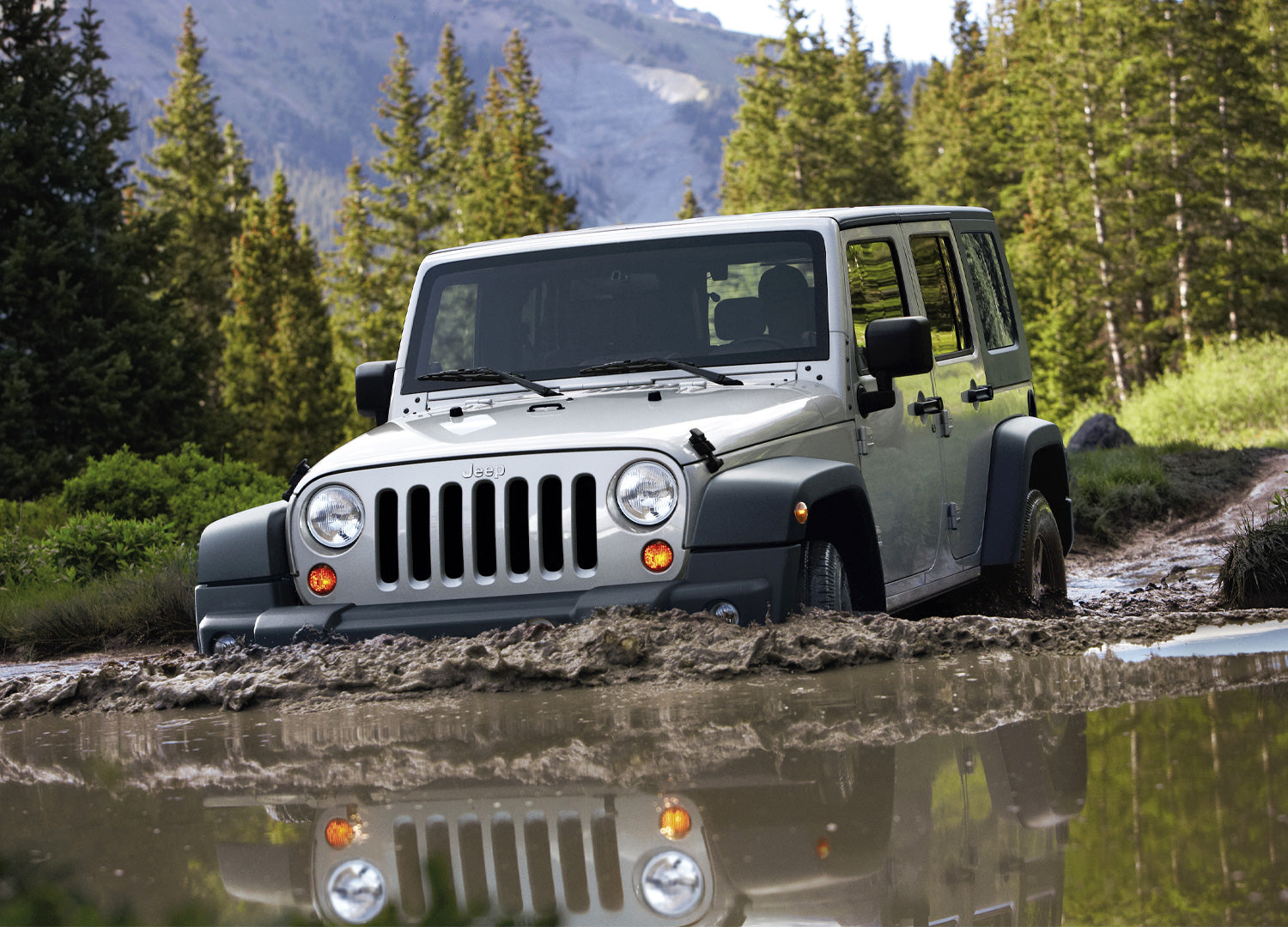You love your Jeep for all its good looks, sweet mods, and off-road prowess, but at its most basic, it’s an engine on wheels. And every engine needs oil. But what kind of oil should you use? And how can you properly change the oil to ensure high performance over time? In this article, we’ll tell you all you need to know about oil for your Jeep.
Why Your Jeep Needs To Have Oil

Your Jeep’s engine is an intricate and sophisticated machine, with tons of fast-moving parts in a relatively small space. Motor oil creates a film that acts as a fluid barrier between bearings, engine pistons, cylinder walls, and other engine components, lubricating the parts so they don’t rub against each other and wear out. An engine without oil will quickly lock up and become damaged beyond repair. Not only does your Jeep need oil, but its oil should be replaced at regular intervals. Over time, heat and contaminants degrade the oil and reduce its lubricating properties. Oil protects against corrosion, thermal breakdown, and engine sludge. Keeping your engine properly oiled with regular oil changes is an easy way to show your Jeep some love and prolong the life of your Jeep.
What Oil Should You Use?

This can be a daunting question for Jeep owners when you consider all the conventional motor oils, blends, and full synthetics on the market today. But the simple answer is that you should use the engine oil type that Jeep recommends for your specific vehicle. So check out that owner’s manual. Jeep engineers carefully craft your vehicle’s engine for optimal performance using specific types of oil. The kind of oil you need will depend on your engine. Newer engines perform best using fully synthetic motor oil with lower viscosity to help maintain maximum efficiency and EPA standards. Older engines may operate better with motor at a higher viscosity. For example, a JL Wrangler with a 3.6L engine needs SAE 0W-20 Full Synthetic Engine Oil, while older JT or YJ Jeep Wrangler engines require either SAE 5W-30 or 10W-30 motor oil. And while it might hurt your wallet in the short run to splurge for the more expensive fully synthetic oil, it’s better for the overall life of your Jeep engine and for the environment. While Jeep recommends Mopar, Pennzoil or Shell Helix, there are tons of reputable brands that provide equivalent quality. Just make sure whatever engine oil type you buy is approved by the American Petroleum Institute (API). Your engine (and your Jeep) will thank you.
Oil Basics
Your everyday oil is a combination of base oil and additives. According to Pennzoil.com, a vehicle’s modern synthetic motor oil consists of about 70 to 90 percent natural gas or distilled crude oil and 10 to 30 percent additives. The base oil does the basic job of lubricating your engine’s various moving parts, reducing friction, and keeping your engine components cool. Regularly changing your oil is the most important step in preventing sludge and deposit build up and keeping your Jeep at peak performance, even in extreme conditions.
Oil Additives
Motor oil alone would not protect your engine for long. All motor oil companies produce blends of refined petroleum and sophisticated additives. These oil additives help with a variety of protection-enhancing features that extend the life of your oil (and engine). Additives such as antioxidants, detergents, and corrosion inhibitors help prevent rust and deposits from forming. Dispersants suspend containments until they can be disposed of. And viscosity index improvers, anti-wear additives, and friction modifiers keep your engine parts fully protected, even at high temperatures. Each bottle of motor oil from a reputable manufacturer is carefully engineered for optimal oil and additive combinations. You can add additional after-market additives, especially if you have an older engine or drive in extreme conditions, but Jeep strongly recommends against additional additives, other than leak detection dyes.
Oil Viscosity
Motor oil viscosity is the measure of its resistance to flow. The more viscous the oil, the more easily it flows and coats your engine, protecting its components from wear and tear. All oil has a viscosity index with two numbers. The first, starting with a W (meaning Winter), measures the oil’s viscosity at low temperatures. The lower the number, the faster it will flow when you start your engine. The second number is the high temperature viscosity and measures the flow of the oil after your engine has warmed up. The lower the number, the faster it will flow around your engine. So a SAE 0W-20 motor oil will flow faster and more easily than a motor oil with a higher viscosity index, like a SAE 10W-40 motor oil. Older Jeep engines often require motor oils with higher viscosity indexes. But as engines have become smaller and more advanced, Jeep engineers have designed engines for use with smaller viscosity indexes, like the 0W-20. Motor oil with smaller viscosity indexes create better engine efficiency, allowing your engine to last longer.
Oil And The Environment
Motor oil can be particularly harmful to the environment. We’ve all seen giant oil spills on the news, with sea birds and seals slick with black gunk. But your DIY oil change can also threaten the environment if you don’t dispose of your oil properly. According to the EPA, motor oil is slow to degrade, can contain heavy metals and toxic chemicals, and can easily contaminate waterways. Part of the Jeep lifestyle is properly caring for the environment that we all love to play in. Recycled motor oil can be cleaned and repurposed as lubricating oil or re-refined into motor oil. So do the right thing and make sure you properly recycle your motor oil. Use this handy site to find a recycling center near you.
Recommended Brands

All the following brands are recommended by Jeep:
- Mopar
- Pennzoil Platinum
- Shell Helix
But any brand that has an API starburst trademark will be high quality, including Mobil, Valvoline, Castrol, Amsoil, and Royal Purple.
How To Change The Oil Properly
An oil change on your Jeep is a crucial task and yes, you could go to a service center and just pay someone else to do it. But oil change services can be a pain, especially if you get shoddy customer service. On the other hand, changing the oil yourself can do more than just save you a few bucks: It can make you feel closer and more bonded with your Jeep and is a great gateway to learning more about your engine. Changing your own oil can build your confidence to tackle more ambitious repair projects in the future, too, saving you even more money—and fewer trips to the mechanic for maintenance service. And thanks to the Jeep engineers, changing your Jeep’s oil is easier than ever. It’s possible to not spill a single drop on the floor. Read on to find out how.
High-Level Basic Process
When it’s time to change your oil, your Jeep might even tell you. The Jeep Wrangler JL will alert you right on the gage cluster. When your Jeep gives you the signal, you first want to prep your engine. You don’t want a hot engine, but do you want a warm engine. Warm your Jeep up by driving it around a little bit—about five to ten minutes—then bring it on into your garage. First, pop the hood and just take a look around to see if your Jeep needs any routine maintenance. Check out your fluids (brake fluid, washer fluid, etc.), make sure your spark plugs are in good shape, and look out for any tar-like residue. Basically give everything a good once-over. Once you’ve done that, you’re ready to get started.
Tools You Will Need
Here’s what you’ll need: a funnel, a pair of latex gloves, a replacement oil filter cartridge, a 13mm wrench, a 24mm socket for the oil filter housing, a small flathead screwdriver, a roll of paper towels or some shop rags, and, of course, some high-quality motor oil like Mopar, Pennzoil or Shell. Make sure you’ve got the right viscosity index. The oil specifications have changed with the JL from older model Jeep Wranglers. It’s best to use fully synthetic oil.
Lastly, you’ll need something to catch your oil, such as an oil pan, and a container to transport the used oil to your local recycling shop.
Flushing Out The Old Oil
The first step is to start the draining process. Get your gloves on, grab your ratchet and socket, and slide on underneath your Jeep to loosen that drain bolt. Jeep perk: The more lifted your Jeep is, the easier it’ll be to crawl underneath. Use the 13mm socket to loosen and remove the oil drain bolt, catching the draining oil in your pan. As the oil drains, you can move back under the hood and use the 24mm socket to unbolt the oil filter, removing it from the cap. Now use the flat head screwdriver to remove the O ring from the oil filter cap. Install the new O ring onto the filter cap and snap the new filter into the cap. Lube the filter gasket a little bit with the new oil and then screw the filter back into the engine, tightening it with the wrench. By this time, the oil should be finished draining. Crawl back under and use the 13mm socket to reinstall and retighten the drain bolt. Go for the Goldilocks amount of torque: not so loose that it will fall out but not so tight it won’t come off next time.
Adding The New Oil
Now it’s time to add the new oil. Remove the oil filler cap and grab the funnel. Now pour carefully, making sure not to spill any oil onto your engine. If you have a JL Wrangler, it should take about 5 quarts of oil. A JK Jeep Wrangler engine will take about 6 quarts of oil while the TJ and YJ will vary between 4 and 6 quarts depending on engine size (click here for a handy fluid chart). Once you’ve filled up the motor oil, jump inside your Jeep and reset the motor oil light. Before you close the hood, give it one last look. This could be a great time to tighten and clean your battery cables or replace your air filters. Everything looks good? Okay, now close the hood. Congrats! Look at you! You just changed your own oil.
Reminders And Tips
How To Avoid Costly Mistakes
Changing your oil sounds easy enough but mistakes can cost you.
Mistake #1: You neglect to replace the oil filter. The filter screens harmful contaminants from your engine and if you don’t replace it every time, you could be getting a new engine sooner than later.
Mistake #2: You spill oil on your engine. Given enough heat, your engine can catch fire, smoking you out of your vehicle. Pour carefully and make sure you replace the oil cap.
Mistake #3: You add the wrong oil viscosity. Your Jeep engine is designed with certain oil passage sizes for a specific oil viscosity. If it says 0W-20, stick with that. Using a different viscosity may reduce the protection for your engine, wearing it down before its time.
Mistake #4: Over or under filling your oil. Putting in too little oil can mess with your hydraulic pressure and lessen lubrication. But putting in too much can be just as damaging, screwing with the hydraulic pressure and causing gaskets and seals to leak. Paying close attention will help you avoid these costly mistakes.
How To Change Oil Without Getting Dirty
No one likes a mess so make sure you are prepared. Have a good pair of latex gloves to protect your hands. Make sure your drip pan is large enough to catch all the oil and make sure that its positioned at the right angle. You might invest in a GarageBOSS drain pan with an easy-to-use funnel to catch every drop. You can also line the drip pan with a garbage bag for easy clean up. When you remove the filter, it might drip so lay some cloth nearby just in case. Lastly, funnels are your friends: Pour safely and slowly, getting the oil only where it belongs. The funnel will also help you pour the old oil into a container for recycling. Follow these tips and you might not even have to wash your hands (though you probably should).
How To Properly Dispose Of Used Motor Oil
As we said above, motor oil can be particularly harmful to the environment, so make sure it’s disposed of properly. Used oil can easily contaminate waterways so do not pour it down a drain or in the garbage. The best way to dispose of it is to recycle it. Transfer your used oil from the drip pan to a spare plastic or metal container (an old Clorox bottle works great, for example). Make sure it’s tightly sealed. And then get it to a place it can be recycled—most auto parts stores will recycle the oil for free or you can use this handy site to find a recycling center near you.
Frequently Asked Questions
How many months can you go on full synthetic oil?
Your synthetic oil should be changed at least every 12 months or 10,000 miles, whichever comes first. If you have a newer Jeep, however, it will tell you when you should change your oil based on your driving conditions and behavior. The length of your trips, engine temperatures, off-roading, driving in extreme conditions, city driving or highway driving will all affect the interval of your oil changes. Your Jeep will let you know.
What oil do Jeep dealers use?
Jeep dealers use Pennzoil fully synthetic oil. Every Jeep that comes out of the assembly line is factory-filled with Pennzoil. It is the brand that Jeep dealers trust most. It’s the one they use for oil change services.
What is the difference between 5W-20 and 5W-30?
The quick answer is that 5W-20 oil is thinner at higher temperatures. It has a lower viscosity and flows more easily when the engine gets hot. This allows the oil to reach engine parts more quickly and creates less friction, thereby improving fuel efficiency and requiring less gasoline. 5W-30 has a higher viscosity index and is thicker at higher temperatures.
Is Synthetic Oil Better?
The short answer is yes. Synthetic oil can be formulated at lower viscosities while still maintaining its protective properties and providing superior lubrication. To meet EPA standards, many automakers design their engines for synthetic oil to help achieve improved fuel efficiency and lower emissions. While synthetic oil is admittedly more expensive than conventional oil, it doesn’t break down as easily, which means a cleaner engine. It provides superior protection from a cold start up to when you’re engine is running hot. You’ll also be able to go longer between oil change intervals while still ensuring high performance. That’s better for the environment (not to mention your wallet).
Can I use 5w30 in my Jeep Wrangler?
Check your owner’s manual. If you have a JL Wrangler with 20.L Engine, then yes, you should use 5W-30 oil. CJ and YJ Wranglers also take 5W-30 motor oil. But most newer Wranglers take 0W-20 motor oil. Using a higher viscosity when your Jeep Wrangler engine doesn’t call for it will harm your fuel efficiency and create more wear and tear.
Do Jeep Wranglers use synthetic oil?
Yes. Modern Wranglers are designed for synthetic engine oil. Jeep recommends using only full synthetics approved by the American Petroleum Institute (API).
What kind of oil does my Jeep Wrangler take?
The answer will depend on the kind of Jeep Wrangler engine you have. For a JL Wrangler with a 2.0L engine, you will need SAE 5-30 Full Synthetic Engine Oil. For JL Wranglers with a 3.6L engine, you will need SAE 0W-20 Full Synthetic Engine Oil. For a 3.0L Diesel engine, will you need SAE 5W-40 Full Synthetic Engine Oil. Earlier generation JK Wranglers take 5W-20 motor oil while CJ, and YJ Wranglers will take either SAE 5W-30 or 10W-30 motor oil. Check your owner’s manual for exact recommendations on your specific engine and model year. Most importantly, don’t be afraid to do this essential task yourself—just be sure to do it well.





